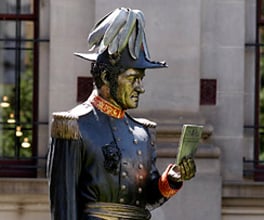Charles La Trobe
Charles Joseph La Trobe was an author, artist and ex-missionary who had helped in the dismantling of slavery in the West Indies. When appointed to the Port Philip District of the Colony of New South Wales, the district that was to be Victoria had around 10,000 settlers. Estimates vary, but perhaps ten times this number of Indigenous Australians lived in the same area.
La Trobe's attitude to Indigenous Australians reflects his strong religious faith, but also the attitudes held by society at the time. While he was outraged by the massacres committed by squatters and attempted to curb frontier violence, he failed to see the damage caused by pastoralists and land dispossession.
By the end of his term in office, La Trobe felt that almost every policy regarding Indigenous Australians had failed. He could cite only the Aboriginal Trackers as: "[One] example of success among the many schemes set on foot to raise the aboriginal native in this quarter of New Holland above his natural level..."
The notion of a hierarchy of 'races'- of groups of people being on different levels- can be seen as the foundation of racist thinking during this period.
La Trobe had known about the possibility of gold for some years but he had suppressed wider public awareness to maintain order. He had greater problems before 1850, like the transportation of convicts and the colony's financial difficulties. The last thing La Trobe needed was more disruption:
The towns of Melbourne & Geelong, and their large suburbs, have been, in appearance, almost emptied of many classes of their male inhabitants. Cottages are deserted, houses to let, business at a stand-still, and even schools are closed. In some of the suburbs not a man is left...
- C J La Trobe
La Trobe, C J 1851, Despatch by La Trobe to Earl Grey of the Colonial office. Unpublished manuscript from the State Library Collection.
La Trobe's decision to tax the miners aggressively and his failure to solve the land problem are counted as his worst mistakes during this period. But the problems he faced were to some degree unprecedented; this was one of the largest movements of people the modern world had ever seen.
Amid increasing pressure, La Trobe submitted his resignation late in 1852, but was not relieved until 1854. This period, where La Trobe hesitated to act and failed to balance the colony's budget is often cited as another flaw in a man whose colony had now grown to more than 300,000 settlers. He suffered a personal blow with the news of the death of his wife who had left to prepare the new family home in Switzerland.
Admirers of La Trobe can point to many achievements. He secured Melbourne's water supply, the Yan Yean Reservoir; he established and reserved space in the city for parks and began work on institutions like the public library and university.
Critics see La Trobe as a man who preferred to 'wait out' the passions of an event rather than act decisively. In this way he could be seen as allowing the tensions behind the licenses, and the lack of land available for colonists, to build and build. It would be a situation that his successor Hotham would be forced to confront.











